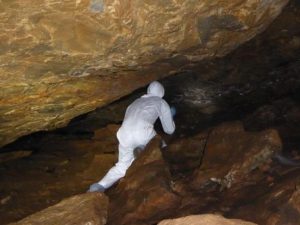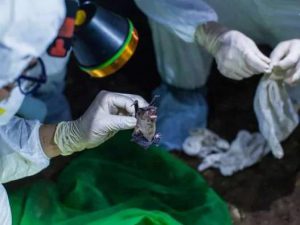APRIL 19, 2020
Deep in the Chinese wilderness, virologists found something unusual in the blood of people living near a mysterious cave full of bats.

A scientist from the Wuhan Institute of Virology collects samples from the Yunnan bat cave, the exact location of which is a closely guarded secret. Picture: EcoHealth AllianceSource:Supplied
In 2004, deep in the wilderness of China’s Yunnan province, a group of scientists from the Wuhan Institute of Virology discovered a cave full of wild bats carrying hundreds of SARS-related viruses.
Their work, published in a draft paper in 2005, unearthed the link between SARS (severe acute respiratory syndrome) and bats for the first time.
Now the virologist who led that study, Shi Zhengli, has revealed one of the strains found in that cave — the exact location of which is a closely guarded secret — is almost identical to the 2019-nCoV coronavirus which has so far killed at least 1,115 people and infected more than 45,000 worldwide.
Professor Shi ran the genome sequence of 2019-nCoV — now officially known as COVID-19 — through the bat-related virus database she built up over ten years and found it was a 96 per cent match to a virus found in the droppings of horseshoe bats.
Horseshoe bats were one of four bat species studied over a five-year period after Prof Shi’s team returned to the cave for a second study.
“It was Ms Shi and her collaborators who, back in 2005, showed that the SARS pathogen was a bat virus that had spilled over into people,” David Quammem, author of Spillover: Animal Infections and the Next Human Pandemic wrote in The New York Times.
“Ms Shi and colleagues have been tracing coronaviruses in bats since then, warning that some of them are uniquely suited to cause human pandemics.
“In a 2017 paper, they set out how, after nearly five years of collecting faecal samples from bats in the Yunnan cave, they had found coronaviruses in multiple individuals of four different species of bats, including one called the intermediate horseshoe bat, because of the half-oval flap of skin protruding like a saucer around its nostrils.”
Ominously, the findings revealed the COVID-19 strain sourced to Wuhan was” distinct from all other coronaviruses”.
“In this sense,” Quammem says, “2019-nCoV is novel — and possibly even more dangerous to humans than the other coronaviruses.”

The team also studied coronaviruses in bats living in caves in Guangdong province. Above, a scientist examines a mouse-eared bat. Picture: EcoHealth AllianceSource:Supplied
Prof Shi’s work also challenges the widely held belief that coronaviruses require an intermediate host to make the jump from bats to humans.
To date, it has been accepted that SARS was transmitted from bats to humans via palm civets and, in the case of its cousin MERS (Middle East respiratory syndrome) from bats to humans via camels.
But Prof Shi found something unusual in the people living near the Yunnan cave: 3 per cent had developed immunity to the viruses, proving the strains can and have infected humans in the past.
However, funding for the project dried up and the research into the virus now known to be a close relative to COVID-19 was suspended.
With scientists still unable to identify an intermediate host for COVID-19 (although snakes and pangolins have been discussed) the possibility it jumped directly from bats to humans is now being taken very seriously.
“Bats are reservoir hosts of several zoonotic viruses, including the Hendra and Nipah viruses, which have recently emerged in Australia and East Asia,” Prof Shi wrote in her 2005 paper, which identified SARS for the first time.
“Bats may be persistently infected with many viruses but rarely display clinical symptoms. “These characteristics and the increasing presence of bats and bat products in food and traditional medicine markets in southern China and elsewhere in Asia led us to survey bats in the search for the natural reservoir of SARS-CoV.”

Wuhan Institute of Virology scientists test samples of bat faeces. Picture: EcoHealth AllianceSource:Supplied
Dr. Peter Daszak, who runs EcoHealth Alliance, a New York based private research organisation that focuses on the connections between human and wildlife health, worked with Prof Shi on both the 2015 and 2017 studies.
“We’ve been raising the flag on these viruses for 15 years — ever since SARS,” he told Quammem for his Times article.
Dr. Daszak said the presence of antibodies against SARS-related coronaviruses in some of the Yunnan cave locals needed further exploration.
“We don’t know if they got sick. We don’t know if they were exposed as children or adults,” he said. “But what it tells you is that these viruses are making the jump, repeatedly, from bats to humans.”
While there is no doubt Prof Shi’s work on coronaviruses is groundbreaking and may even hold the key to developing a vaccine, many Chinese blame her for causing the Wuhan outbreak.
In recent weeks, she has been the subject of allegations COVID-19 escaped from her lab — the Wuhan Institute of Virology — which is located at the epicentre of the outbreak and a focus of many a conspiracy theory.
“Work like this usually gets plaudits and praise, and sure enough Shi moved into the limelight. But for all the wrong reasons,” the South China Morning Post reported.
“Daily internet searches for Shi’s name increased 2000 times (in the wake of the outbreak), yet most posts on China’s internet and social media about her were negative.
“Some people called Shi the “mother of the devil”.
Prof Shi has vehemently denied the allegations. Last week, according to the SCMP, she sent a message to her friends on social media site WeChat.
“I swear with my life (the virus) has nothing to do with the lab,” she wrote.
Courtesy/Source: NEWS Australia










































































































